Watching a group of fish that swim together in unison can bring a feeling of order to even the most chaotic aquascape.

For this reason, I wanted to put together a resource listing some schooling fish species that can go in your new freshwater aquarium.
Most of the species listed here are appropriate for beginner aquarists. I also cherry-picked small fish that can fit in something like a 10-gallon tank but included some species for larger tanks too.
Fish that are colorful and lively were a priority during my research.
So let me show the 11 schooling freshwater aquarium fish that will best fit in your setup.
Let’s dive in.
11 Schooling freshwater aquarium fish that will swim together
For the purpose of this article, I need to make sure you know the difference between “schooling” and “shoaling” fish:
Schooling fish are species that would swim together harmoniously. Shoaling fish are the ones that need to stay in a group of their own kind but won’t necessarily keep tight and swim in unison.
That being said, any fish that thrives in a social hierarchy needs to have at least five companions of its own in the same aquarium.
Otherwise, the fish may become stressed which can result in unnecessary aggression and even a shortened lifespan. Also, a group of six specimens is the bare minimum and doesn’t guarantee success.
For this reason, to be on the safe side, I recommend keeping ten fish of the same kind if possible.
That being said, have a look at the schooling fish that could go in your new freshwater aquarium:
1. Celestial Pearl Danio – Danio margaritatus

by joelouis1987
| Minimum Tank Size: | 10 or more gallons in tanks with a longer horizontal length |
| Section They Swim in: | Bottom to the middle of the tank |
| Maximum Body Size: | 1 inch (nearly 2.5 cm) |
| Suitable for Beginners: | Yes |
The Celestial Pearl Danio is a pretty and colorful schooling fish that grows to no more than 1 inch of body length.
As most species that come from the Danio genus, Celestial Pearl Danios – also known as Galaxy rasbora – prefer subtropical water temperatures. Because of their tiny size, you can keep them in larger groups which helps them feel more confident.
A confident group of Celestial Pearl Danios would swim in the middle section of the aquarium.
However, it’s not unusual to find these fish schooling primarily in the bottom part of the water column.
Celestial Pearl Danios are also restless swimmers and will not waste time staying in one place.
When choosing a tank for these nano fish consider how active they are and the fact that they prefer swimming over longer distances. I’d recommend going with a tank that’s long and not tall.
There’s a standard 10-gallon Long tank with a length of 24 inches, which can be ideal for a school of 6 to 10 Celestial Pearl Danios.
Even better, however, would be to put a larger school in a 20-gallon Long tank, which has close to 30 inches of length.
The Celestial Pearl Danio does best in heavily planted tanks since that type of setup resembles its natural habitat the most.
2. Neon Tetra – Paracheirodon innesi
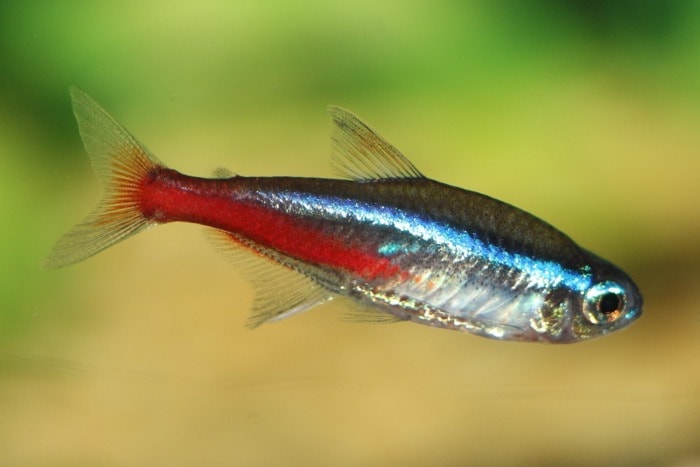
by MokryBajzel
| Minimum Tank Size: | 10 gallons for a group of 7 but preferable in a tank with more horizontal space |
| Section They Swim in: | Middle or bottom of the water column |
| Maximum Body Size: | Up to 1.4 inches or 3.5 cm |
| Suitable for Beginners: | Yes |
The Neon Tetra comes from the Paracheirodon genus and is one of the smallest aquarium fish that like to swim in a tight school.
An adult Neon Tetra will reach about 1.5 inches in size but this does not mean you can put them in a 5-gallon tank . The natural behavior of these South American fish depends on how large their group is.
They do best in schools of 10 or more specimens. A 10-gallon tank is acceptable for a group of 7 but that’s the bare minimum for a functional school of Neon Tetras.
A better option would be to stock a 20-gallon “Long” tank with 15 specimens and watch them thrive.
Neon Tetras used in their aquarium will relentlessly dash through the middle layer of the water column.
That being said, there are a couple of reasons why a Neon Tetra may act timid and primarily swim near the bottom level of the tank:
- The tank needs more live plants which are perceived as a safer environment by the fish;
- Its tank mates are relatively larger or aggressive;
- The fish was recently introduced to the aquarium and doesn’t feel confident yet.
Because of their similarity, members of the Paracheirodon genus are often mistaken for one another.
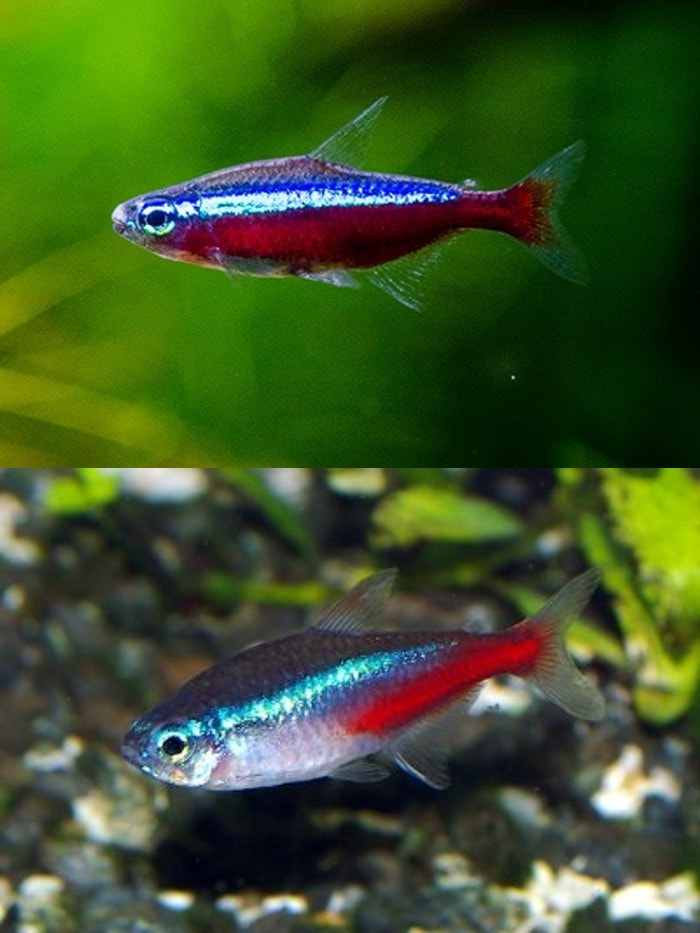
Cardinal Tetra by Spit1A and Neon Tetra by mattmc12
Neon Tetras, which are P. innesi, get confused with the Cardinal Tetra, which is actually Paracheirodon axelrodi.
Both fish species have four lines of sharply contrasting colors along their body.
Pay attention to the red line if you don’t want to make a mistake:
The red line of a Neon Tetra starts in the middle of the body and extends to the tail.
The red on Cardinal Tetras goes from the gill and all the way to the tail.
Cardinal Tetras also grow to about 2 inches in size.
3. Roseline Shark – Sahyadria denisonii

by jcardona1
| Minimum Tank Size: | 75 gallons or more, but ideally a tank with 70+ inches of horizontal length |
| Section They Swim in: | Preferring the middle of the water column |
| Maximum Body Size: | Between 5 and 6 inches on average (12.7 to 15.2 cm) |
| Suitable for Beginners: | Yes |
Commonly referred to as Roseline Sharks the Sahyadria denisonii species is also known as Denison Barb.
As the name suggests the body of this fish species resembles a shark. This is great in itself because there aren’t many options for shark-like creatures in the freshwater aquarium hobby .
The Roseline Shark is also ideal for aquarists who seek to fill their large aquarium with active schooling fish.
That’s because these fish grow to about 6 inches and need a good amount of swimming space in their fast-paced life.
A 75-gallon aquarium is a bare minimum for a school of 6 Roseline Sharks. However, it’s much better to get a larger school and put them in a 125-gallon one.
The Roseline Sharks would patrol the middle section of your large aquarium and their vivid colors will provide a nice contrast to a darker substrate with green aquatic plants. One good substrate for a tank with lots of Roseline Sharks is the Black Diamond Blasting Sand.
4. Zebra Danio – Danio rerio
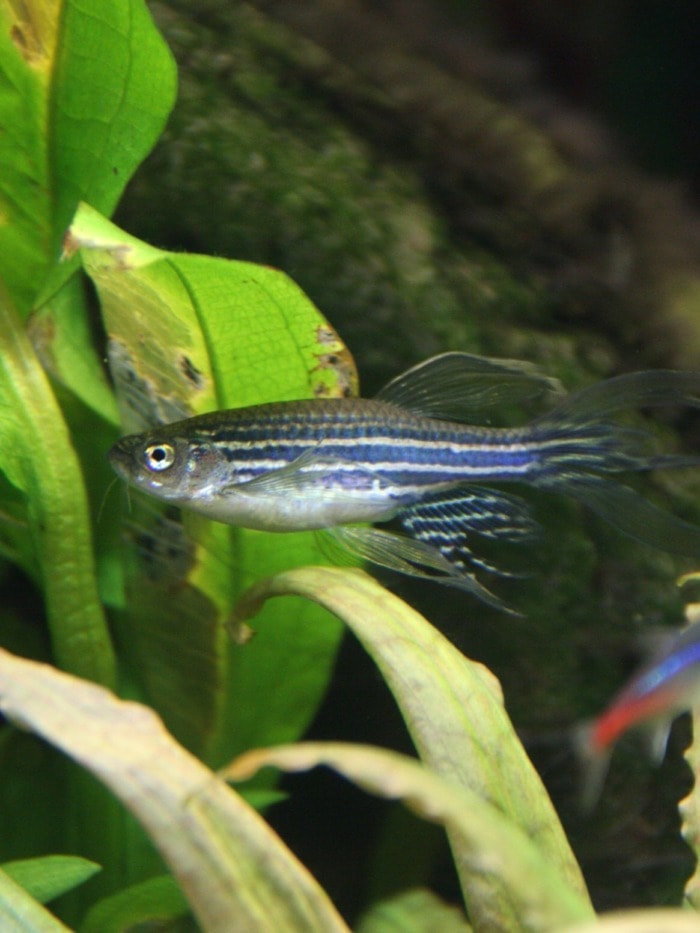
by Popeye
| Minimum Tank Size: | 20-gallon “Long” tank for a group of 7 to 8 |
| Section They Swim in: | Top and sometimes the middle |
| Maximum Body Size: | 2.2 inches or 5.6 cm but on a rare occasion a specimen can reach 2.5 inches in length (6.3 cm) |
| Suitable for Beginners: | Yes |
The hardy Zebra Danio (Danio rerio) is one of the most popular freshwater aquarium fish for beginners. If you have the means to get a 20-gallon tank and want to try keeping a beautiful schooling species that like subtropical temperatures then the Zebra Danio is for you.
Zebra Danios grow to about 2.2 inches in their adulthood and need all the horizontal swimming space they can get.
You’ll need to keep them in groups of at least 7 because that’s how they form their social hierarchy.
If the school is too small then Zebra Danios become stressed and needlessly aggressive. Stress from not being among their own kind can eventually shorten their lifespan.
Anyway, Zebra Danios have also been bred as a GloFish.
GloFish are genetically modified fish species that seem to glow in the dark. If you’re into that kind of thing you can check my article on GloFish tank mates for setup ideas.
5. Dwarf Chain Loach – Ambastaia sidthimunki

by HairyCatFish
| Minimum Tank Size: | 20-gallon “Long” |
| Section They Swim in: | Bottom dweller |
| Maximum Body Size: | 2.5 inches (6.3 cm) |
| Suitable for Beginners: | Yes |
The Dwarf Chain Loach is a member of the Ambastaia genus and as such is a typical nano botia species.
It reaches 2.5 inches of maximum size and needs to form a community with its own species.
Dwarf Chain Loaches should be kept in schools of at least 6 specimens, but 10 is preferable. Of course, the more – the better.
Anyhow, these fish are hyperactive and will tirelessly scavenge the bottom of your aquarium, while keeping in a tight group.
Because of their activity, it’s not recommended to put them in tanks that have less than 30 inches of horizontal length.
One thing to keep in mind with this nano fish is that it needs very well-oxygenated water if you are to have them in a tropical aquarium.
If you like the idea of tiny schooling loaches you can also research Tuberoschistura arakanensis, or the Rosy Loach. The Rosy Loaches grow to about 1.2 inches and have the same care requirements as the Dwarf Chain Loaches.

Rosy Loach by Graeme Robson and Dwarf Chain Loach by HairyCatFish
Anyway, like most loaches, the Dwarf Chain Loach will have an appetite for aquatic snails. These fish are ideal for keeping your community aquarium clean of small pest snails.
Make sure your tank has lots of decorations that the Dwarf Chain Loaches can explore.
6. Boesemani Rainbowfish – Melanotaenia boesemani

by Broadfield
| Minimum Tank Size: | Some recommend 30-gallon tanks but I’d like to see them in tanks of 55 gallons or above |
| Section They Swim in: | In the middle of the water column |
| Maximum Body Size: | 4.5 inches for a male (11.4 cm) and up to 3 inches for females (7.6 cm) |
| Suitable for Beginners: | Not for absolute beginners but in general they are not difficult to look after |
Boesemani Rainbowfish are members of the very rich Melanotaenia genus and are a popular choice for a colorful aquarium. The males have brighter, more distinctive colors and grow to about 4.5 inches.
The females reach up to 3 inches in body length and look what some would classify as more dull.
I would not personally put a school of Boesemani Rainbowfish in any tank that holds less than 55 gallons. That’s because, in my experience, smaller tanks somewhat confine these middle-dwelling fish.
Anyway, when it comes to temperament the Boesemani Rainbowfish are very chill and peaceful.
They prefer to stay away from conflict and would rather just swim back and forth.
The Boesemani Rainbowfish is an ideal species for a community aquarium as long as their tank mates are equally peaceful and similar in size. These fish thrive in a heavily planted tank so make sure to provide their home with lots of vegetation.
Though chill, the Boesemani Rainbowfish are aggressive feeders. They feed like how a Largemouth Bass would, throwing themselves at the food. This behavior could stress other slow-swimming tank mates which may end up malnourished.
7. Kuhli Loach – Pangio kuhlii

by X3NiTH
| Minimum Tank Size: | 55-gallon tank for a school of 7, but ideally 125-gallon because these are active fish |
| Section They Swim in: | Bottom |
| Maximum Body Size: | Up to 4 inches or 10 cm |
| Suitable for Beginners: | Yes |
The Kuhli loach is what you would want to keep if you have a tropical freshwater setup but enjoy looking after eel-like pet fish. Each specimen ends up about 4 inches in body length when fully grown.
Unlike most other fish on this list, these oddballs tolerate being in smaller schools.
You can put 3 Kuhli loaches in a 20-gallon “Long” aquarium.
However, If you don’t get a larger school, AND a larger tank you may be missing out. That’s because in larger schools Kuhli Loaches become extremely outgoing and entertaining to observe.
Essentially, these exotic-looking fish will cuddle each other, while exploring every inch of your fish tank’s bottom. For this reason, this is the only fish species I push for to be kept in an exceptionally large tank, contradicting many other sources.
Anyway, the Kuhli loach is one of the very few schooling fish that can go along with Angelfish. That’s because the Kuhli loaches will stay out of the Angelfish’s face most of the time.
Also, these loaches are not aggressive fin nippers, which is welcome for a fish with large fins such as the Angel.
Author’s tip: If you insist on having an Angelfish along with schooling fish, make sure to only get one of the former. Also, choose schooling fish that are not famous for fin-nipping, which most tetras are if not kept in a huge school of 12 or more.
8. Odessa Barb – Pethia padamya

by brewmaster15
| Minimum Tank Size: | 30 gallons but that’s pushing it, so I recommend going for a 55-gallon tank |
| Section They Swim in: | Middle |
| Maximum Body Size: | 3.5 inches but there are specimens that can reach 4 upon good care (8.9 to 10.1 cm) |
| Suitable for Beginners: | Yes |
Given its relatively small size of 3.5 inches, the Odessa barb seems like a fish that could fit in smaller aquariums.
However, these fish do tend to become aggressive if they’re not in a school of 10. For this reason, I recommend going with a tank that has ample horizontal length, and the 55-gallon one is a good choice.
Moreover, in a tank with such dimensions, you could put even more than ten Odessa barbs, which would make for a lively setup. The Odessa barb mainly dwells in the middle section of an aquarium.
However, it can also be seen swimming at the top or bottom water level of the tank.
Author’s note: If you like the Odessa Barb but have a smaller tank then check out its cousin the Cherry Barb (Puntius titteya). Cherry Barbs are also schooling fish but grow to be no more than 2 inches in length.
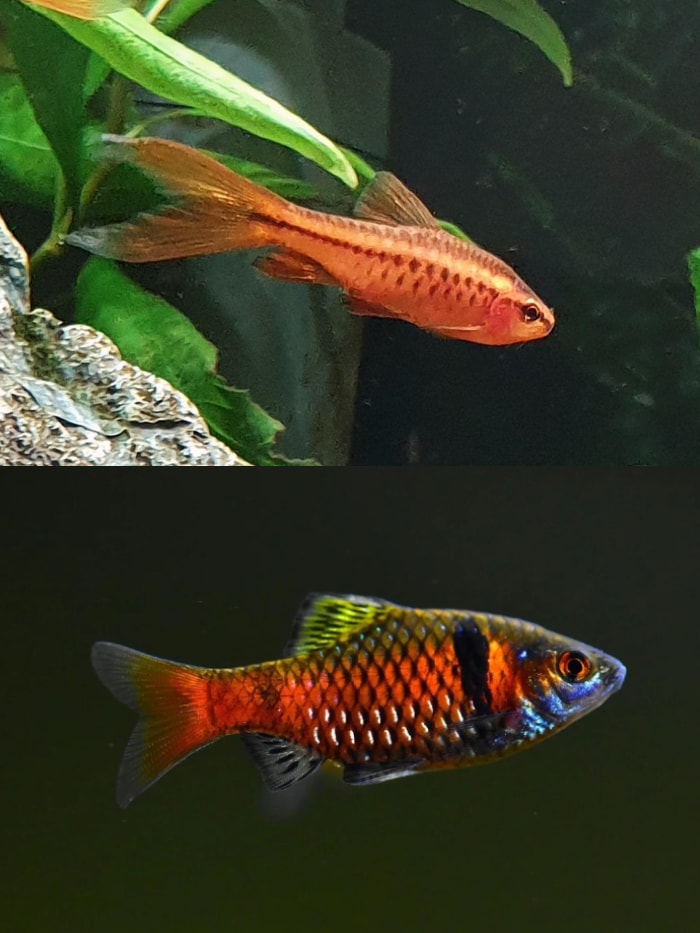
Cherry Barb by justcallmeryanok and Odessa Barb by WillAtleastThisDo
Anyway, one of the best qualities of this fish species is its adaptability.
Odessa barbs can adapt to almost a wide range of water temperatures and acidity.
If you’re new to the whole schooling fish thing I recommend seriously considering them for your new aquarium.
Just make sure to also put some cool live plants in there because Odessa barbs tend to stand out in a planted aquascape.
9. Chili Rasbora – Boraras brigittae
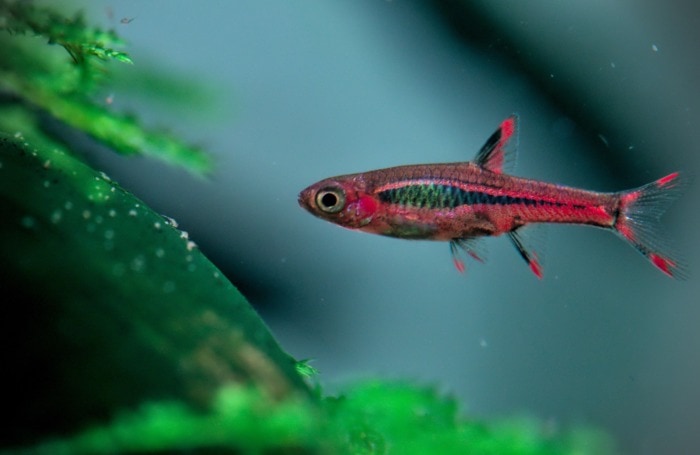
by mahard
| Minimum Tank Size: | 5 gallons but that’s only if you’re an experienced fish keeper, otherwise – 10 gallons |
| Section They Swim in: | Middle and top |
| Maximum Body Size: | 0.78 inches or just about 2 cm |
| Suitable for Beginners: | No |
Chili Rasboras, also known as Boraras brigittae, are some of the smallest schooling species in the aquarium hobby. They grow to about 0.8 inches and are brightly colored, which makes them ideal for a small planted tank.
Because the Chili Rasboras are not active swimmers you could safely put up to 12 specimens in a 5-gallon tank.
The school will calmly traverse the tank’s length while keeping at the middle or top of the water column. However, don’t get too excited about Chili Rasboras unless you’re particularly experienced in the hobby.
These tropical nano fish are sensitive to shifts in water parameters and prefer a low pH. Maintaining low and stable water pH in small tanks is no easy feat.
Moreover, Chili Rasboras need to be in a heavily planted aquarium to feel safe and confident. All of this makes taking proper care of Chili Rasboras challenging for a beginner.

Least Rasbora by Traumfahrer and Dwarf Rasbora by greenbryde
The Boraras genus is composed of fish that look and behave similarly to the Chili Rasbora. You can find all varieties in fish stores. If you decide you can handle these dwarf fish, you should also check out Boraras urophthalmoides (Least Rasbora) and the Boraras maculatus (Dwarf Rasbora).
10. Harlequin Rasbora – Trigonostigma heteromorpha
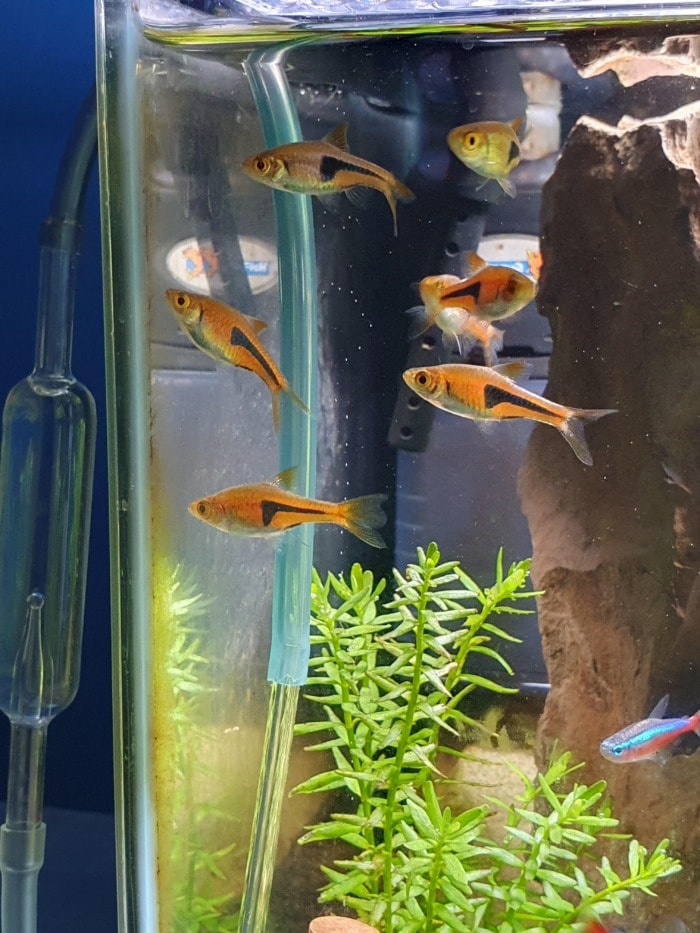
by schoenveter69
| Minimum Tank Size: | 10 gallons |
| Section They Swim in: | Midwater column |
| Maximum Body Size: | 2 inches (5.1 cm) |
| Suitable for Beginners: | Yes |
Harlequin Rasboras are extremely popular among hobbyists from all ranks, from beginner to expert.
The reason behind this is their relatively small size of 2 inches (5.1 cm) and their ease of care.
But the good things about Harlequin Rasboras don’t end here.
Aside from not being too picky about super precise water parameters Harlequin Rasboras also look great in a tank, thanks to their unique color pattern and entertaining behavior.
Their “lambchop-like” mark on the side of the body is very recognizable and makes an impression on house guests.
The remarkable Harlequin Rasboras swim in groups in the midwater column and should be kept in schools of no less than 7 specimens.
11. Ember Tetra – Hyphessobrycon amandae
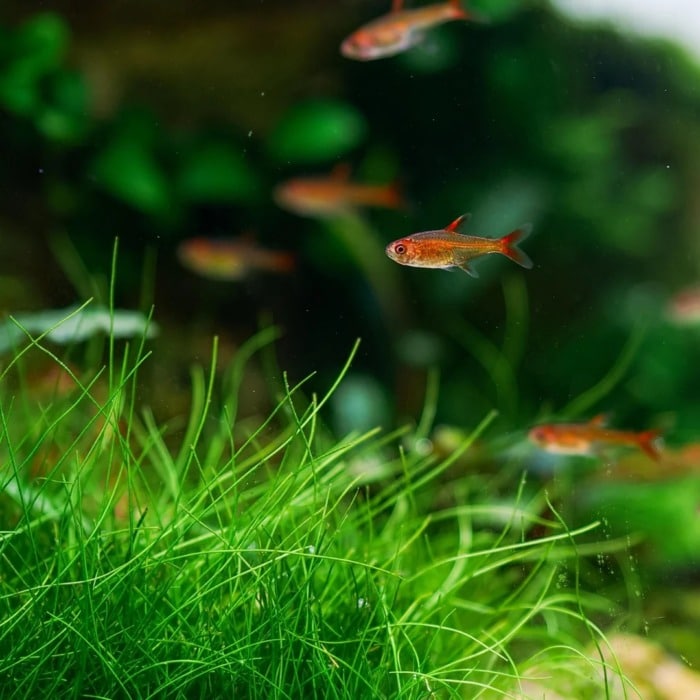
by AquaristForFun
| Minimum Tank Size: | at least a 10-gallon tank |
| Section They Swim in: | Midwater column |
| Maximum Body Size: | 0.7 inches on average (1.8 cm) |
| Suitable for Beginners: | Yes |
Coming from the genus Hyphessobrycon, the Ember Tetra is a brightly colored nano fish that thrives when kept in schools.
Ember Tetras are a fantastic nano fish to try as a beginner, because they catch the eye while staying very active in a tank.
The more space you give these fish to cover – the better.
I prefer keeping large schools in long tanks because I enjoy the bustling communities they make.
You won’t have a boring aquarium if you keep a group of Ember tetras in there, that’s for sure.
Just keep in mind that initially they will seem a bit shy, but don’t let that fool you.
Eventually all Ember Tetras become the restless swimming machines they are meant to be.
Finally, thanks to their beautiful orange color, a school of Ember Tetras works very well in densely planted tanks, because of the contrast they provide.
What fish need to live in groups but do not school together (shoaling fish)?
There are many types of fish that prefer to live in groups of their own but do not strictly school together harmoniously.
That’s called shoaling.
That’s essentially the difference between schooling and shoaling fish. Shoaling fish stay in groups and are loosely organized, while schooling fish swim in the same direction, in unison.
Most freshwater livebearers from the Poeciliidae family are one example for shoaling fish.
Shoaling members of this family will become needlessly aggressive if not in large groups.
These are famous fish such as the guppies, the mollies, the platies, and the swordtails.
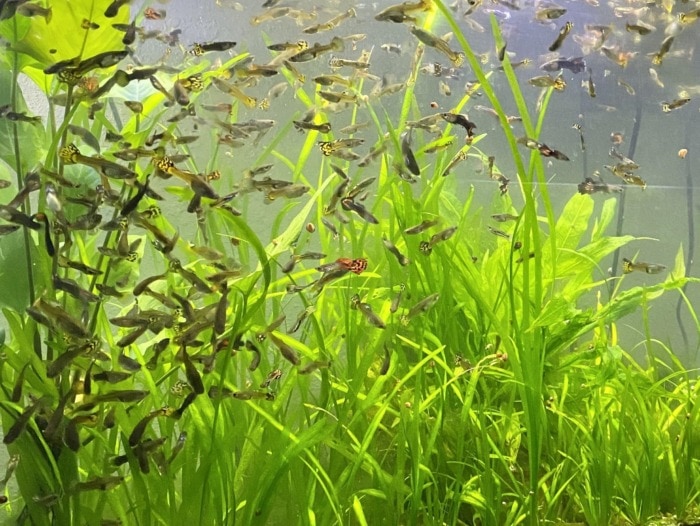
by heydoughnuts
Another example where group living is encouraged is among fish that do well in what’s known as a “harem”.
In fish keeping, a group of one male and a couple of females is called a harem.
This type of setup applies to species such as the Sparkling Gouramis and the Licorice Gouramis.

Sparkling Gourami by freshpine
In both species, the males would get aggressive with each other and are therefore only kept along with females.
Some killifish and rainbowfish are also best kept in harem aquariums.
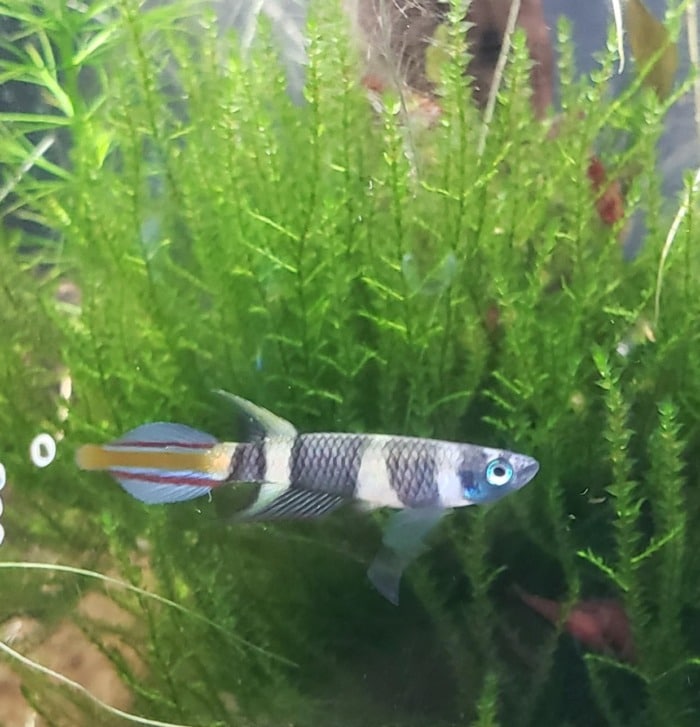
by angierre
Final thoughts
Choosing what schooling fish to put in your new tank can be difficult if you don’t have some sort of summarized info.
I hope that my research gave you a few useful stocking ideas.
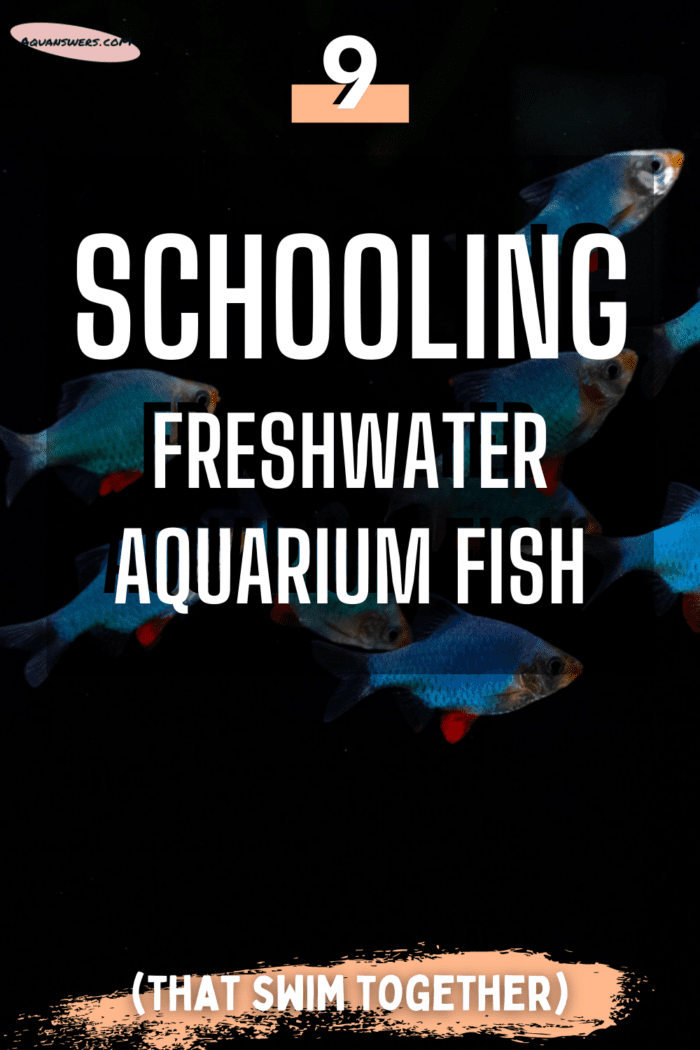
Feel free to post any questions or feedback you may have in the comment section.





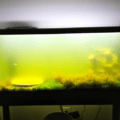
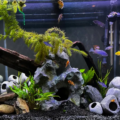



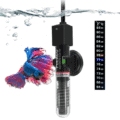
*most of the fish species you mentioned
I loved your insight and knowledge on the subject. No beginner I have a 60 gallon tank with most of the decors you mentioned. You helped fill in a few gaps for me. Thank you!
Gratitude. 🙏
Thank you for being a reader, Jonathan.
Fishkeeping is all about learning something new even after years of experience 🙂